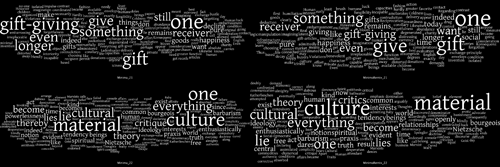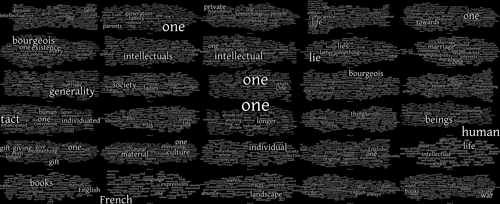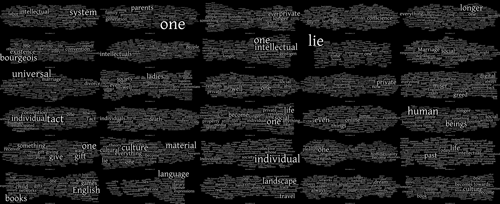The following post was originally released on Remix Theory on August 14, 2013. It is reposted to give an idea of the research process that led to Remix Data as an online resource.
Image 1: Word cloud visualizations of Theodor Adorno’s Minima Morlia, aphorisms 21 and 22 on the left and their corresponding remixes on the right. (Click image for detail)
My first post for Minima Moralia Redux is dated October 16 2011, but I had done much research prior to this date. I had been reading extensively on Theodor Adorno and his work, while also creating visualizations of YouTube viral memes for my post-doc at The Department of Information Science and Media Studies at the University of Bergen in affiliation with The Software Studies Lab in San Diego, now also based in NYC. As I analyzed meme patterns, it became evident that much of the material that is discussed in terms of remixing in music and video, which is also quite popular across media culture, usually relies on acts of selectivity–meaning that with the ubiquity of cut/copy & paste, people tend to re-contextualize pre-existing material, much how DJs and producers used sampling to remix in dance music culture during the eighties. [1]
Image 2: Word cloud visualization of the first thirty aphorisms in Theodor Adorno’s Minima Moralia. (Click image to view large file)
Minima Moralia Redux is a type of mashup, itself, of art, writing as a literary act, and media research that explores how data visualization is providing new possibilities for understanding creative processes. The project explores the selective remix, which arguably is quite popular across culture since cut/copy and paste became a common act due to daily use of computers. Certainly this is the type of remixing that most people debate over in remix culture. The selective remix consists of evaluating the source material and deciding what to leave and what to omit, as well as what to add, all while making sure that the source material remains recognizable.[2] This means that large parts are kept as originally produced while others may be radically different. A tension in authorship develops, as the remixer clearly shows creativity quite similar to an “author’s.” At the same time, the remixed work relies heavily on the cultural recognition of the author and his/her work. Much has been written about such tensions, but it is my hope that the research I am now introducing here in preliminary fashion will be a contribution to understanding how we come to create works that appear to be autonomous and credited to a single person, and how we can move past such conventions to more productive approaches that do justice to the way culture is communicating at an ever increasing pace.
Image 3: Word cloud visualization of the remixes of the first thirty aphorisms in Theodor Adorno’s Minima Moralia (Click image for large file)
Minima Moralia Redux has various layers of significance. First, I wanted to explore, as I already explained, how the selective remix functions. I decided to do this by embedding myself in the process, as opposed to studying another person’s remix. In this project, I examine each entry carefully, do research on it, and eventually re-write it to make it relevant to issues that are taking place in contemporary times. While doing this, I keep in mind that it is the voice of Adorno that is at play here. This means that I need to make sure that Adorno’s theories remain his. In other words, it is not necessarily my opinion that is expressed in the remixes, although I do take creative license and adjust– even critique Adorno’s views within his own writing. This is no different than a music remixer who often times will create a different piece of music, one which nevertheless, is not credited to him/her as author/artist, but only as a person who remixed the author’s work. In the case of music this is done in the commercial sector for increasing sales, but in remix culture, it is done because people may simply love doing it, and/or are fans of the artist/author. Taking this approach with Adorno’s work, I argue, is only fair given that Adorno himself believed in revising one’s view on life and the world. In the 1960s, he admitted that some of his critical analysis in Dialectic of Enlightenment, which he co-wrote with Horkheimer, no longer stood their ground in 1969. He considers the book “a piece of documentation.” By this Adorno and Horkheimer let the book be part of history. [3] Based on this critical position on his part, it is very unlikely, for instance, that in 2013, he would use the word “savage” as he did when he wrote aphorism 32.[4] The result of this approach in Minima Moralia Redux is a new text that is clearly still in large part Adorno’s, but which I hope resonates with the language and issues of the twenty first century.
I rewrite each aphorism one sentence at a time, evaluating it word for word. I study the history of particular words, and evaluate the sentence’s relevance during the times when the book was written. I then consider how it may be understood and at play in contemporary times. When I rewrite the aphorisms I am conscious of the way remixing functions in music and video, and apply it to writing to see what the results may be. At the same time, I become immersed in the creative process based on intuition as I am also interested in exploring aesthetics. I use two translations for the rewriting of each entry. The first is by Dennis Redmond, available on Marxists.org, and the other is the official English publication of Minima Moralia translated by E. F. N. Jephcott for Verso Press. I combine parts from both sources, while adjusting sentence structure, and I add and delete material to come up with a statement that is relevant to contemporary times.
For the word cloud visualizations I use Many Eyes, an online resource developed by Martin Wattenberg for IBM. The clouds are useful to evaluate how often words are repeated in the original entries. The visualization of the original text appears at the top of each blog entry. The main section of each post consists of the remixed text with a link to the original source available on Marxists.org. At the bottom is a thumb image of the same visualization along with a second visualization of the actual remix. These thumb images are presented with each post to provide a quick understanding of how key terms are reused and others omitted, while others are added in accordance to the principles of selective remixing. The reader can click on each thumb image to view a detailed version and compare them. I provide two visualizations of aphorisms at the top of this entry (image 1).
The visualizations expose the constant usage of particular words, and when comparing the original entries to the remixed versions, it becomes evident how selectivity is at play. For instance, one can notice in aphorisms 21 and 22 that some of the words that are more pronounced in the original entry are still repeated often in the remixed versions, while others disappear and others are added (larger words means more repetition, smaller, less frequent). This is similar to how remixing functions in music as well. I am also evaluating sentence structure and actual number of word repetition for each visualization. I will be releasing a concrete analysis of all this in the future in connection to viral memes, as well as a set of YouTube video mashups. The latter research I have not made available online at all, but two of the videos part of this research can be found on page 106 in my book Remix Theory. My research of the selective remix as found in the thirty entries that I share on this post is part of my examination of selectivity in other forms of online media production. The idea to look at how remixing functions in text developed out my research in analyzing video. My findings so far have been that there are patterns that certainly crossover among image, music and text, which enables the viewer or reader to sense how remixing is at play in particular pieces.
So far I have remixed thirty-five aphorisms, and provide visualizations of thirty of them as part of this post. Image 2 offers an overall sense of the originals, and image 3 a comparative sensibility of how they were changed after they were remixed. The process behind the production of each remixed entry takes quite some time to perform, so it will be a while before I can release my final version of this project. This brief entry should at least provide some details on the process that makes Minima Moralia Redux possible.
Below I provide a two column comparative visualization of the first thirty aphorisms(image 4). On the left are the original entries, and on the right appear the remixes. Examining one next to the other provides an idea of how different patterns are at play within and across the originals and the remixes, while looking at them as a large group gives a sense of the aesthetics of writing as a creative act–something that certainly cannot be fully measured, but one could hope can be appreciated.
Image 4: A two column comparison of the first thirty aphorisms of Theodor Adorno’s Minima Moralia and their remixed versions. Comparing each aphorism with its corresponding remix shows the process of selectivity that takes place in remixing text, which is deliberately performed, in this case, along the line of music remixing.
[1] I go over much of this in my book: Remix Theory: The Aesthetics of Sampling.
[2] If too much material is omitted, then the remix may start to lean towards other types of remixes which will not be discussed in this instance. See chapter three inRemix Theory.
[3]Mark Horkheimer & Theodor Adorno, Dialectic of Enlightenment, trans. Edmund Jephcott (Stanford: Stanford University Press, 1987), xi -xii.
[4] See my remix, which is an extensive critique of Adorno’s conflicted bourgeois position, by using his own words:http://minimamoraliaredux.blogspot.com/2013/06/minima-moralia-32.html




